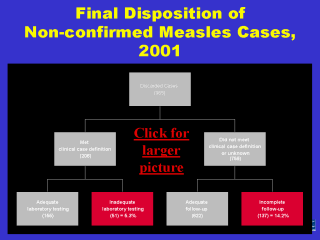| front |1 |2 |3 |4 |5 |6 |7 |8 |9 |10 |11 |12 |13 |14 |15 |16 |17 |18 |19 |20 |21 |22 |23 |24 |25 |26 |27 |28 |review |
 |
Among the 1100 suspected cases of measles reported to our surveillance system in 2001, 965 were eventually discarded because they could not be confirmed as actual measles cases. If we look at the different reasons why these suspected cases were discarded, we see that for the 206 which met the clinical case definition for measles, 155 were eventually discarded because laboratory testing revealed they were not cases of measles. In addition, of the 759 suspected cases which did not meet the clinical case definition for measles or had an unknown status, 622 cases were eventually discarded because follow-up case investigations revealed information that indicated these were not actual cases of measles. While our surveillance system was able to determine the status for approximately 80% of our suspected cases, it did not provide laboratory testing for 51 cases (5.3%) or follow-up investigations for 137 cases (14.2%) adequate to determine their confirmatory status. This suggests that our surveillance system needs to improve both its laboratory testing and investigative capacities. As we can see, examining the disposition of discarded cases helps us understand how well our surveillance system is performing. The limitation of this approach is that it requires collecting a lot of information on cases that ultimately are ruled out, which some might consider an inappropriate use of limited resources. Nonetheless, when this information is available, it provides some assurance that cases are being suspected, reported, and appropriately investigated. |
| front |1 |2 |3 |4 |5 |6 |7 |8 |9 |10 |11 |12 |13 |14 |15 |16 |17 |18 |19 |20 |21 |22 |23 |24 |25 |26 |27 |28 |review |